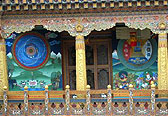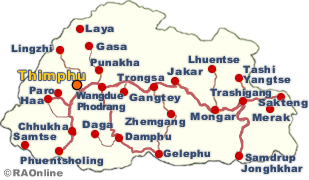 |
Bhutan History |
|
 |
Bhutan Information |
|
|
 |
 |
Archeological evidence suggests that Bhutan was inhabited by nomadic herders as early as 2000-1500 BC. Although the destruction of original documents in fires and earthquakes has left much of Bhutan's ancient history obscure, a few of the scriptures that were saved from such natural disasters reveal the prominence of Buddhist tradition and mythology. Other sources rely on reports from British explorers, and on legend and folklore. |
Recorded
Bhutanese history dates back to the 747 AD when Guru Rinpoche first visited the country.
 |
| Regarded
as the second Buddha and the patron saint of Bhutan, he introduced the
Buddhist religion in the country, providing a sense of cohesion during
the middle ages. |
|
Until
the early 17th century, Bhutan was a cluster of fragmented provinces
constantly at odds with each other.
It was Zhabdrung Ngawang Namgyal (1594 - 1651),
a great spiritual personality and leader who brought an end to warring
factions and unified the country into one nation, establishing a theocracy
in 1652 and introducing a code of law.
In the process of crushing
several foreign invasions, mainly from Tibet, he initiated the building
of many fortresses called Dzongs, which to this day, serves as centers
of administration in the country.
The
theocracy established by Zhabdrung endured until 1907 when Ugen
Wangchuck was elected as the first hereditary king of Bhutan by popular
consensus.
Jigme Wangchuck succeeded him and ruled the country from 1926
to 1952.
Jigme Dorji Wangchuck, also known as the father of
modern Bhutan, was king from 1952 to 1972.
His
Majesty Jigme Singye Wangchuck ascended to the throne in 1972. Jigme Singye Wangchuck was king from 1972 to 2006 .
The present king His
Majesty Jigme Singye Wangchuck ascended to the throne in 2006.
| Dzongs founded by Zhabdrung Ngawang Namgyal |
 |
| Information on Bhutan |
 |
|





